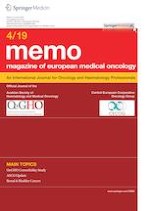-
Bacillus Calmette–Guérin (BCG) instillation immunotherapy is the standard adjuvant treatment for most intermediate and all high-risk nonmuscle invasive urothelial carcinomas (NMIBC) after transurethral resection of the bladder (TUR/B)
-
Intravesical BCG with maintenance therapy has proven effective in reducing recurrence as well as progression rates, but up to 40% of patients eventually become BCG unresponsive
-
Radical cystectomy is the standard treatment for BCG unresponsive and intolerant patients, but is associated with significant morbidity rates often representing overtreatment in a subset of patients
-
Checkpoint inhibition (CKI) immunotherapy has become an effective standard therapy for metastatic bladder cancer and could represent a promising alternative therapy in high-risk and BCG unresponsive bladder cancer alone or in combination with BCG
-
Interim results of the KEYNOTE-057 phase II trial evaluating pembrolizumab in high-risk bladder cancer patients unresponsive to BCG reported complete response rates of 40% at 3 months
-
Further immunotherapy phase II and phase III trials testing CKI alone or in combination with BCG in the BCG unresponsive or naïve setting are currently ongoing and will determine which patients benefit most from CKI therapy in the adjuvant setting
BCG therapy and definition of BCG unresponsiveness
BCG and activation of the immune system
Checkpoint inhibitors and activation of the immune system
Current trials for adjuvant NMIBC therapy
Name | Phase | Treatment | Drug | Target | Population | No. Planned | Start date | End date | Study design | Primary endpoint |
|---|---|---|---|---|---|---|---|---|---|---|
KEYNOTE-057 NCT02625961 | II | Pembrolizumab, 200 mg, iv, every 3 weeks for up to 24 months | Pembrolizumab | PD1 | BCG-unresponsive, ineligible for or refusal of RC | 260 | February 10, 2016 | July 30, 2023 | Single Group Assignment | CRR, DFS |
KEYNOTE-676 NCT03711032 | III | BCG + pembrolizumab iv every 3 weeks for 35 doses vs. BCG mono therapy | Pembrolizumab, BCG | PD1 | HR NMIBC and treated with at least 1 course of BCG induction therapy | 550 | December 24, 2018 | November 25, 2024 | Randomized Parallel Assignment | % with CIS achieving CR |
NCT03504163 | II | Pembrolizumab after TUR as single agent, 3‑week intervals for 9 doses | Pembrolizumab | PD1 | HR T1 NMIBC | 37 | June 27, 2018 | March 31, 2016 | Single Group Assignment | % DFS |
NCT02844816 | II | Atezolizumab iv every 21 days for up to 17 cycles | Atezolizumab | PD-L1 | Recurrent, NMIBC, unfit for RC, BCG-unresponsive | 202 | February 7, 2017 | April 1, 2021 | Single Group Assignment | CR at 25 weeks for CIS, event-free survival at 18 months in BCG-unresponsive |
ALBAN NCT03799835 | III | BCG + atezolizumab (every 3 weeks for 1 year) vs. BCG | Atezolizumab, BCG | PD-L1 | HR NMIBC | 614 | January 17, 2019 | February 1, 2028 | Parallel Assignment | RFS |
NCT02901548 | II | Durvalumab iv every 4 weeks for 13 cycles over 12 months | Durvalumab | PD-L1 | BCG unresponsive | 34 | February 16, 2017 | December 31, 2021 | Single Group Assignment | CR at 6 Months |
NCT03759496 | II | Durvalumab weekly intravesical for up to 6 weeks or until progression/toxicity | Durvalumab | PD-L1 | HR NMIBC, refractory to BCG, intolerant to BCG | 39 | November 15, 2018 | December 31, 2021 | Single Group Assignment | Max tolerated dose, HGFR |
POTOMAC NCT03528694 | III | Durvalumab + BCG (IND + MAIN; IND only or BCG only) | Durvalumab | PD-L1 | HR, BCG-naïve, previously BCG but stopped >3 years ago | 975 | May 14, 2018 | November 25, 2024 | Randomized Parallel Assignment | Efficacy of Durvalumab + BCG, DFS |
CheckMate 9UT NCT03519256 | II | Nivolumab vs. Nivolumab + BCG vs. Nivolumab + BMS-986205 vs. Nivolumab + BMS-986205 + BCG | Nivolumab, BCG | PD1 | BCG-unresponsive | 436 | May 25, 2018 | April 16, 2023 | Randomized Parallel Assignment | CIS participants with CR, Duration CR, EFS |
PREVERT NCT03950362 | II | 60–66 Gy in 30-33 Fractions to bladder; Avelumab before EBR, then 8 cycles Avelumab | Avelumab | PD-L1 | BCG-unresponsive, HR, unfit for RC | 67 | June 15, 2020 | June 15, 2024 | Single Group Assignment | RFS at 1 year |
